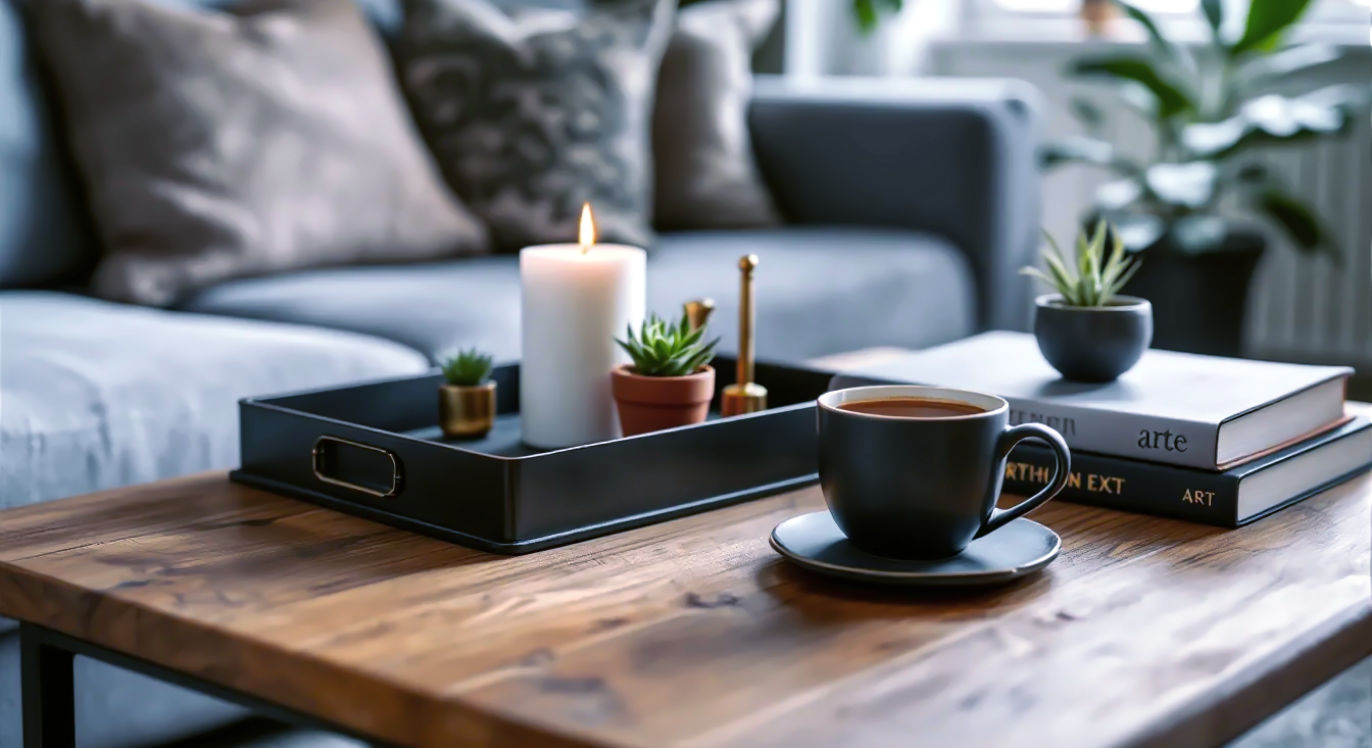The Art of the Centrepiece: A Guide to Styling Your Coffee Table
Unlock the secrets to a beautifully styled coffee table. This complete guide covers everything a British home needs, from core design principles to practical tips.

This post may contain affiliate links. If you make a purchase through these links, we may earn a commission at no additional cost to you.
Pull up a chair, pop the kettle on. Let’s talk about the unsung hero of the British living room: the coffee table. For most of us, it’s the faithful hub of daily life. It’s where we drop our keys, rest our cuppas, and stack the day’s post. It’s a footrest during Gogglebox, a makeshift desk for last-minute work, and a battlefield for board games on a rainy Sunday.
But more often than not, it becomes a cluttered island of forgotten mugs, tangled charging cables, and that one book you’ve been meaning to read for six months. We look at those stunning living rooms in magazines or on Instagram and wonder, “How do they make it look so effortlessly chic?”
Here’s the secret: it’s not magic, and it’s certainly not about having an empty, untouchable surface. Styling a coffee table is an art, but it’s one you can easily master. It’s about creating a small, curated world that is both beautiful and functional—a perfect reflection of your personality and a focal point that ties your whole room together.
This guide will walk you through everything you need to know, from the fundamental design principles to a step-by-step blueprint for creating a display that feels both professionally arranged and uniquely you. So, let’s transform that cluttered surface into a stylish centrepiece. Biscuit, anyone?
The Foundation: Unlocking the Core Principles of Styling
Before we even think about what to put on the table, we need to understand the ‘why’. Great styling isn’t about randomly plonking down a few nice things. It’s a careful balancing act, guided by a few simple design principles. Get these right, and you’re already halfway to a stunning result.
Scale and Proportion: Getting the Size Just Right
Think of this as the Goldilocks rule. Your decorations shouldn’t be too big or too small for your table; they should be just right. A tiny, single vase on a vast, chunky wooden table will look lost and lonely. Likewise, a gigantic floral arrangement on a delicate, small table will feel overwhelming and clumsy.
- Simplified Explanation: Match the size of your decor to the size of your table.
- Detailed Explanation: Aim for your main decorative objects to occupy roughly two-thirds of the table’s surface area, leaving plenty of ‘breathing room’ around the edges. This negative space is just as important as the objects themselves, as it prevents the display from looking cramped. If you have a large statement piece, like a big bowl, balance it with smaller items rather than more large ones.
Balance and Weight: Creating Visual Harmony
This is about how you distribute your items to create a sense of equilibrium. It doesn’t mean everything has to be perfectly symmetrical—in fact, asymmetry often looks more modern and interesting. It’s about distributing the visual weight so one side of the table doesn’t feel heavier than the other.
- Simplified Explanation: Don’t put all your heavy-looking stuff on one side.
- Detailed Explanation: If you have a tall, heavy stack of books on the left, balance it with something that has a similar visual presence on the right—perhaps a collection of three smaller vases or a sculptural object. This creates a pleasing tension and guides the eye across the entire surface, rather than letting it get stuck in one spot.
Height and Variation: Avoiding the Flat-Pack Look
One of the most common styling mistakes is having everything at the same height. A flat display is a boring display. You want to create a mini-landscape with peaks and valleys that make it visually exciting.
- Simplified Explanation: Use a mix of tall, medium, and short items.
- Detailed Explanation: Your eye loves to travel up and down. A tall vase of flowers or elegant candlesticks can provide a dramatic high point. A stack of books creates a mid-level platform, and a small decorative bowl or a paperweight can act as a low point. Aim for at least three different height levels in your arrangement to give it rhythm and dimension.
Texture and Touch: Adding Depth and Warmth
A display that only appeals to the eye is missing a trick. Great interior design engages multiple senses. Texture is key to making your coffee table feel inviting and sophisticated. It’s the difference between a room that looks like a showroom and one that feels like a home.
- Simplified Explanation: Mix up smooth, rough, soft, and hard materials.
- Detailed Explanation: Think about contrasting surfaces. Place a rough, ceramic vase on a smooth, glossy book. Put a metal tray on a wooden table. Add a string of wooden beads or a small woven coaster. These tactile differences create layers of interest and prevent the arrangement from feeling one-dimensional. Consider materials like marble, wood, glass, ceramic, brass, and even natural elements like stone or coral.
Colour and Cohesion: Tying the Room Together
Your coffee table isn’t an isolated island; it’s part of the bigger picture of your living room. The colours you use on it should connect to the rest of the space—the cushions, the rug, the art on the walls.
- Simplified Explanation: Use colours on your table that are already in your room.
- Detailed Explanation: Pick two or three key colours from your room’s palette and repeat them in your coffee table decor. This creates a sense of intention and makes the whole space feel cohesive. For example, if you have a navy blue sofa and ochre cushions, a book with an ochre spine or a small navy blue box on the table will instantly tie everything together. Don’t be afraid of a bold pop of a contrasting colour, but keep it limited to one or two small items to make a real impact.
The Stylist’s Toolkit: Your Essential Decorating Ingredients
Now for the fun part: choosing what to put on your table. Think of these as your core ingredients. You don’t need all of them, but a combination of three or four will almost always create a winning recipe.
1. The Anchor: Trays and Platters
If you take only one piece of advice from this article, let it be this: get a tray. A tray is the single most useful tool in coffee table styling. It works like a frame for a picture, instantly corralling smaller items—like a candle, a small plant, and your remote controls—into a neat, deliberate-looking group.
It’s also brilliant for practicality. When you need to clear the table for drinks or a game of Monopoly, you can just lift the entire tray away in one go. Choose a material that adds texture, like wood, marble, metal, or even woven rattan.
2. The Foundation: Coffee Table Books
They’re called coffee table books for a reason! Large, hardback books on subjects you love—art, fashion, travel, photography, architecture—are perfect styling tools. They add intellectual weight, a splash of colour, and, most importantly, they create a platform for layering other items on top.
How to stack them:
- Create a stack of two or three books.
- Arrange them with the largest at the bottom and the smallest on top.
- Align the spines for a neat look, or stagger them slightly for a more relaxed feel.
- Use the top book as a mini-stage for a smaller object, like a candle or a decorative box.
3. The Life: Plants, Flowers, and Natural Touches
Every room needs something living in it, and your coffee table is the perfect place for a touch of nature. It breathes life and energy into the space and prevents your display from feeling too static or sterile.
- Flowers: A vase of fresh flowers is always a winner. You don’t need a huge, expensive bouquet—a few simple stems of eucalyptus or some seasonal blooms from the garden can look just as beautiful.
- Plants: For a lower-maintenance option, a small potted plant like a succulent, an orchid, or a trailing ivy adds a lovely touch of green.
- Other Natural Elements: Think beyond plants. A bowl of interesting stones or shells, a piece of driftwood, or even a beautiful pinecone in autumn can connect your home to the outdoors.
4. The Light: Candles and Diffusers
A coffee table display should appeal to the sense of smell as well as sight. Candles are a styling staple for a reason. They add a soft, sculptural shape, and lighting them in the evening creates a wonderfully cosy and inviting atmosphere.
Choose a candle in a beautiful container—glass, ceramic, or marble—that complements your decor. Tapered candlesticks in elegant holders can also add wonderful height and a touch of old-world charm. A stylish reed diffuser is another great option for adding a constant, subtle fragrance to the room.
5. The Personality: Sculptural and Personal Objects
This is where you inject you into the display. This is the object that tells a story, sparks a conversation, or simply makes you smile. It could be anything:
- A quirky sculpture you found at a flea market.
- A beautiful ceramic bowl from a local artisan.
- An antique magnifying glass.
- A small, elegant box for hiding away remotes or coasters.
- A treasured object from your travels.
This ‘object of curiosity’ is what elevates your table from a generic arrangement to a personal statement. Choose something with an interesting shape that contrasts with the more rectangular books and trays.
The Blueprint: A Step-by-Step Guide to Perfect Styling
Right, you’ve got your principles and your ingredients. Now, let’s put it all together. Follow these simple steps for a foolproof arrangement every time.
Step 1: The Clean Slate – Start with Nothing
The most important step! Remove absolutely everything from your coffee table. Give it a good clean. It’s impossible to style effectively on top of existing clutter. This gives you a fresh perspective and a blank canvas to work with.
Step 2: Lay Your Foundation – Place Your Tray or Books
Start with your largest items, as they will anchor the entire display. This will typically be your tray or your main stack of coffee table books. Don’t place it dead centre unless you have a square table and are aiming for a very symmetrical look. Usually, placing it slightly off-centre creates a more dynamic feel.
Step 3: Introduce Height – Add Your Tallest Item
Next, place your tallest object. This will usually be a vase with flowers or branches, or a pair of candlesticks. This immediately breaks up the horizontal plane of the table and creates a focal point. A good rule of thumb is to place it towards the back of the arrangement so it doesn’t block the view across the room or obscure the TV.
Step 4: Build Your Vignettes – The Rule of Threes
Interior designers swear by the “Rule of Threes.” The human brain finds groupings of three (or any odd number) inherently more appealing and natural than even-numbered groups.
Think about creating small clusters or ‘vignettes’ on your table.
- On your tray, you might have a candle, a small plant, and a decorative object. That’s one group of three.
- Next to your stack of books, you might have a vase. The stack of books counts as one item, the vase is the second, and perhaps a small bowl is the third.
Step 5: Add Life and Light – Weave in Nature and Scent
Now is the time to add your living elements and sources of light. Place your potted plant or your vase of flowers. Position your candle or diffuser. These elements soften the arrangement and make it feel complete.
Step 6: The Final Edit – Step Back and Tweak
This is crucial. Styling is a process of addition and subtraction. Once you think you’re done, step back. Walk around the table. Look at it from where you sit on the sofa.
- Does it feel balanced?
- Is there enough empty space?
- Can you still reach for your cup of tea?
- Is anything blocking a key sightline?
Don’t be afraid to move things around, take one thing away, or swap something out. Often, the best arrangements are the result of a little bit of playful tweaking.
Mastering Different Shapes and Surfaces: A Tailored Approach
Not all coffee tables are created equal. The shape and material of your table will influence your styling choices. Here’s how to adapt your approach.
Styling a Rectangular or Square Coffee Table: The Grid Method
These are the easiest shapes to style. Think of the surface as being divided into a grid of four quadrants. You don’t have to fill all of them, but it’s a helpful way to organise your display. You could place a stack of books in one quadrant, a tray in another, a larger vase in a third, and leave the fourth empty for drinks. This keeps things feeling organised and balanced.
Styling a Round or Oval Coffee Table: The Triangle Trick
With a round table, you want to avoid placing things in a straight line. The best approach is to create a triangular arrangement. Place your three main items (or groups of items) in a triangle shape in the centre of the table. For example, a tall vase at the top point of the triangle, a stack of books at the bottom left, and a candle on a tray at the bottom right. This creates a balanced, central display that works from every angle.
Styling a Glass or Acrylic Coffee Table: The Art of Lightness
With a transparent table, what’s underneath is just as important as what’s on top. A beautiful rug or interesting floorboards will be visible, so you don’t want to cover them up with heavy, solid objects.
- Embrace Light: Use decor that plays with light—coloured glass, metallic objects, and delicate items.
- Ground It: A single tray or a stack of books is essential to ground the display and stop everything from feeling like it’s floating.
- Bottom Shelf: If it has a lower shelf, use this for more practical storage (like magazines or books) and keep the top surface relatively clear and simple.
Styling an Ottoman or Upholstered Table: Function Meets Form
Styling an ottoman requires one non-negotiable item: a large, sturdy tray. This provides a stable, flat surface for you to place drinks and decorative items on, protecting the fabric beneath. You can then treat the tray as your ‘coffee table’ and style it using all the principles we’ve discussed. The rest of the ottoman can be left clear for putting your feet up.
Styling Nesting Tables: A Dynamic Duo (or Trio)
Nesting tables offer a fun, layered styling opportunity. Don’t try to style them as one unit. Treat each table as a separate surface. You might place a larger arrangement on the main table (e.g., books and a plant) and just a single, simple item on the smaller, tucked-in table (e.g., a candle or a set of coasters). This creates a sense of depth and allows for flexibility.
Advanced Styling: Telling a Story and Adapting with the Seasons
Once you’ve mastered the basics, you can start having more fun and letting your personality truly shine through.
Creating a Narrative: What Does Your Table Say About You?
Think of your coffee table as a 3D mood board. The objects you choose can tell a story about your passions, hobbies, and history.
- The World Traveller: Display a book on Moroccan design, a trinket from a trip to Japan, and a candle with a sandalwood scent.
- The Art Lover: Showcase a sculpture by a local artist, books on Monet and Picasso, and a vase that’s a work of art in itself.
- The Nature Enthusiast: Use a wooden tray, a book on British birds, a plant, and a candle that smells of pine forests.
This thematic approach makes your styling feel cohesive and deeply personal.
Seasonal Styling: A Fresh Look for Every Time of Year
Changing your coffee table decor with the seasons is a simple way to make your whole living room feel refreshed.
- Spring: Swap heavy throws for lighter textures. Introduce fresh, light-coloured flowers like tulips or daffodils. Use scents like citrus or floral.
- Summer: Bring in coastal vibes with a piece of coral, a shell, or a book with a beautiful seascape cover. Use a lighter-coloured tray, perhaps in white or rattan.
- Autumn: Embrace warmer tones. Think amber-coloured glass, a bowl of small pinecones, and candles with cosy scents like cinnamon or spiced apple. Add a small pumpkin or gourd in October.
- Winter/Christmas: This is the time for festive touches. Add some sprigs of holly or eucalyptus, fill a bowl with baubles, and use plenty of candles to create a warm glow.
The Functional Table: Balancing Beauty with Real Life
Let’s be realistic. Your coffee table needs to work for a living. The key is to integrate the practical bits into your beautiful display.
- Remotes: Ditch the ugly plastic tray they came in. Hide them in a stylish decorative box or neatly line them up on your main tray.
- Coasters: Don’t hide them away. Find a set of beautiful coasters—marble, slate, or wood—and make them part of the decor. Stack them neatly on a pile of books or on your tray.
- Mugs and Glasses: The whole point of the table is to have somewhere to put your drink! Leaving clear, usable space is a core part of good styling. Your styled vignettes should only take up a portion of the table.
Common Coffee Table Crimes: Pitfalls to Avoid
We’ve all been there. Here are a few common mistakes and how to easily fix them.
- The Overcrowded Catastrophe:
- The Look: Every square inch is covered. It feels chaotic and there’s no room to put anything down.
- The Fix: Take everything off and start again. Be ruthless. Choose only your favourite, most impactful pieces and give them breathing room. Remember, empty space is your friend.
- The Sea of Smalls:
- The Look: A collection of lots of tiny, unrelated items (small candles, tiny photo frames, little trinkets) that just look like clutter.
- The Fix: Gather them all up. Use a tray to group the best ones into a single, cohesive unit. The tray will give them presence and make them look intentional.
- The Lifeless Landscape:
- The Look: Everything is hard, flat, and man-made. Lots of books, boxes, and trays, but nothing organic or soft.
- The Fix: Add life! A simple plant or a few stems of flowers will instantly transform the display. Also, check your textures—add something natural like wood or a string of beads.
- The Functionality Fail:
- The Look: It looks stunning, but it’s completely impractical. The vase is so big you can’t see the TV, or there’s nowhere to put down a cup of coffee without risking a domino-style collapse.
- The Fix: Style from the perspective of someone actually using the room. Keep sightlines clear and always leave dedicated, empty space for, well, coffee.
Conclusion: Your Table, Your Story
Your coffee table is more than just a piece of furniture; it’s the heart of your living space. It’s a canvas for your creativity and a reflection of your life. Styling it shouldn’t be an intimidating chore, but a joyful, creative process.
Forget rigid rules and the pressure to create a picture-perfect showroom. Start with the core principles—balance, height, texture—and then layer in the things you truly love. Experiment, play around, and don’t be afraid to change things up.
Ultimately, the most beautifully styled coffee table isn’t one that follows a formula perfectly. It’s one that tells your story, invites conversation, and makes you feel happy every time you walk into the room and set down your cup of tea.
Further Reading
For more inspiration from trusted sources in British interior design, explore these excellent resources:
- Livingetc: A leading modern home and style guide, full of contemporary inspiration.
- Elle Decoration UK: The authority on stylish, beautiful, and sophisticated interiors.
- Mad About The House: An award-winning blog by Kate Watson-Smyth, packed with practical advice and design wisdom.






